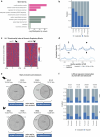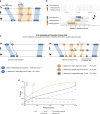Conservation of regulatory elements with highly diverged sequences across large evolutionary distances
- PMID: 40425826
- PMCID: PMC12165850
- DOI: 10.1038/s41588-025-02202-5
Conservation of regulatory elements with highly diverged sequences across large evolutionary distances
Abstract
Developmental gene expression is a remarkably conserved process, yet most cis-regulatory elements (CREs) lack sequence conservation, especially at larger evolutionary distances. Some evidence suggests that CREs at the same genomic position remain functionally conserved independent of sequence conservation. However, the extent of such positional conservation remains unclear. Here, we profiled the regulatory genome in mouse and chicken embryonic hearts at equivalent developmental stages and found that most CREs lack sequence conservation. To identify positionally conserved CREs, we introduced the synteny-based algorithm interspecies point projection, which identifies up to fivefold more orthologs than alignment-based approaches. We termed positionally conserved orthologs 'indirectly conserved' and showed that they exhibited chromatin signatures and sequence composition similar to sequence-conserved CREs but greater shuffling of transcription factor binding sites between orthologs. Finally, we validated indirectly conserved chicken enhancers using in vivo reporter assays in mouse. By overcoming alignment-based limitations, we revealed widespread functional conservation of sequence-divergent CREs.
© 2025. The Author(s).
Conflict of interest statement
Competing interests: The authors declare no competing interests.
Figures













References
MeSH terms
Substances
Grants and funding
- IB139/1-1/Deutsche Forschungsgemeinschaft (German Research Foundation)
- IB 139/6-1/Deutsche Forschungsgemeinschaft (German Research Foundation)
- IB139/6-1/Deutsche Forschungsgemeinschaft (German Research Foundation)
- 101076709/EC | EC Seventh Framework Programm | FP7 Ideas: European Research Council (FP7-IDEAS-ERC - Specific Programme: "Ideas" Implementing the Seventh Framework Programme of the European Community for Research, Technological Development and Demonstration Activities (2007 to 2013))
LinkOut - more resources
Full Text Sources

